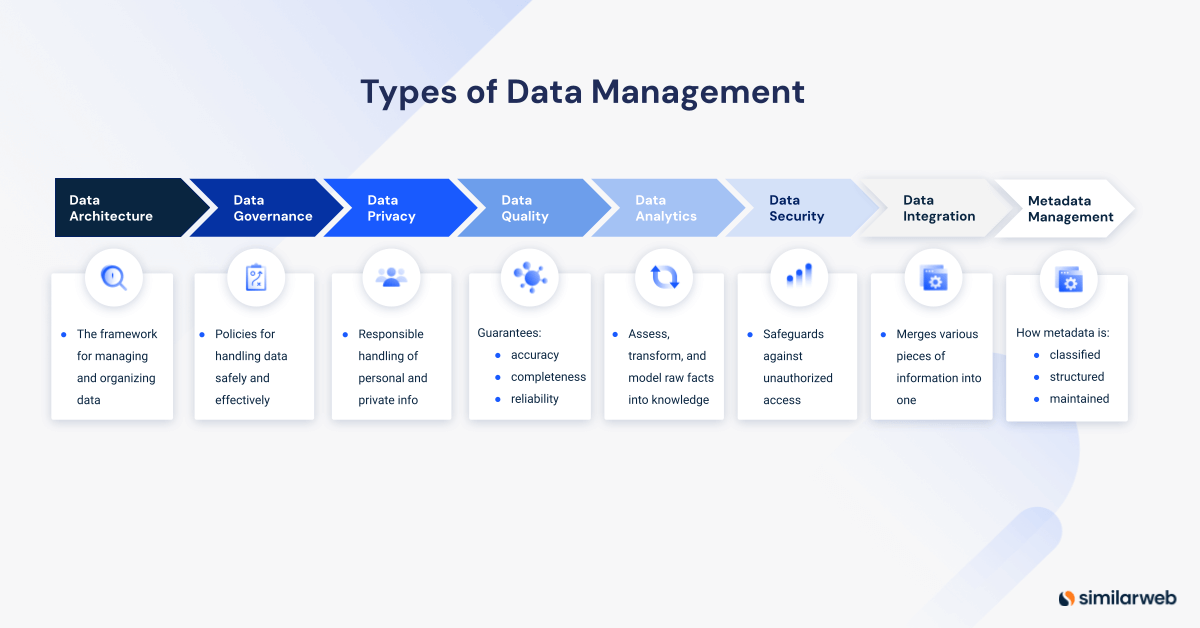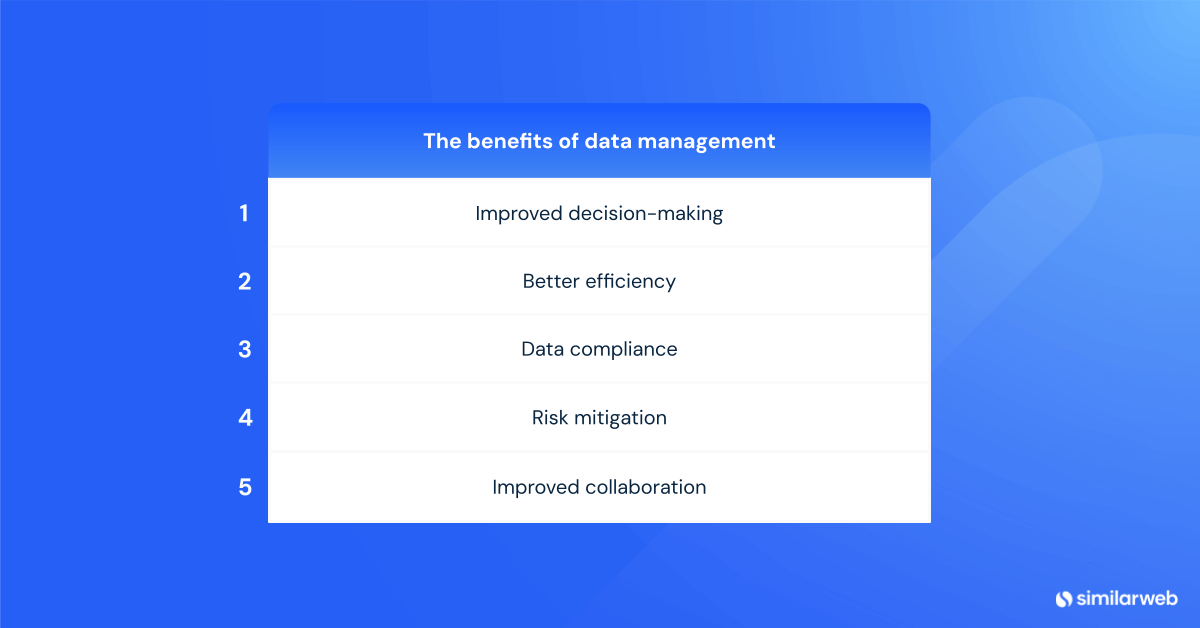 DaaS
DaaS
What Is Data Management and Why Is It Important?

Data is everywhere, and the digitalization of everyday life means we must process it more than ever before. Any forward-facing organization must come to terms with mastering the art of data management. This all-inclusive guide demystifies the different dimensions of managing data, including its diverse forms, criticality, and numerous benefits.
As we travel this path, we’ll learn that effective data management requires more than simply managing large volumes of information. It involves converting such information into a strategic asset, leading to growth, innovation, and competitive advantage.
What is data management?
Data management is a structured and strategic process involving meticulous collection, storage, organization, and maintenance of data. It is an essential component for making sure that the right decisions are made based on readily available, reliable up-to-date data.
The ability to transform raw unstructured data into valuable business insights through proper data handling practices is what makes it powerful. Businesses need to convert their raw data into usable information to make informed decisions about the products/services they offer or plan on providing in the future.
Effective business strategies require accurate market intelligence. Without this, firms cannot make informed decisions based on the changing demands of their industry. Effective data management is crucial for an organization focused on embracing the vast amount of information at hand.
Types of data management
1. Data architecture
Designing a framework for managing and organizing data is known as data architecture. It establishes how and where data will be stored, accessed, and controlled in an organization by ensuring that the data follows processes with ease. In addition, this blueprint is needed to maintain consistency.
2. Data governance
Data governance involves setting up policies and rules for handling data safely and effectively. It helps protect data integrity by determining how the organization accesses and uses its information resources. Effective governance ensures high-quality information is maintained in compliance with regulations.
3. Data privacy
This application focuses on dealing with personal or private information delicately. It also calls for the implementation of measures, such as encryption of information, to comply with legislation on the protection of personal data. It is focused on privacy considerations towards building trust and maintaining a corporate image.
4. Data quality
Data quality management guarantees the accuracy, completeness, and reliability of the information. This can involve improving processes, removing errors from databases, or finding more efficient ways to update records – any step that will improve the way decisions are made within the organization. High-quality input into business operations relies on correct details necessary for analysis.
5. Data analytics
This refers to assessing, transforming, and modeling raw facts into knowledge. This entails deploying statistical techniques together with software to parse out key elements from diverse datasets. Business intelligence (BI) can’t do without this type of system functioning properly when it comes to informed long-term planning.
6. Data security
Data security safeguards against unauthorized access to computerized systems through passwords or other forms. The strategy may include protection strategies like encryption techniques or imposing regular checks to make sure that any sensitive information remains private and confidential.
7. Data integration
This aims at merging various pieces of information into one. This is particularly true for organizations that deal with data from multiple sources and want it to be consistent throughout. This process is crucial for analysis and reporting purposes.
8. Metadata management
This is responsible for handling secondary information. In other words, this pertains to how metadata is classified, structured, and maintained so that it can be easily found, retrieved, or managed. When metadata is managed effectively, the data’s usability and discoverability within the organization are improved.
Why is data management important?
Data management is vital for businesses today. It has become the core of contemporary business strategies and is responsible for properly using data analytics. This process is fundamental in handling the constant expansion of digital information, which results in a valuable asset when coming up with new ideas and strategies. Let’s look at some of the reasons why strong data management is essential.
Efficiency and organization
Data management primarily helps streamline organizational operations. It allows access to relevant information quickly and easily, boosting productivity on a grand scale. This means that users can focus more on their daily routines rather than spending hours looking for a specific document or reading through files full of irrelevant information.
Smarter decision-making
Quality data management complements the reliability and accuracy of information. Having one reliable main source removes any discrepancies or uncertainties that may arise from having multiple sources of information. Data-driven decision-making can be made quicker and with more confidence throughout your entire organization.
Advanced data protection
With frequent cases of hacking making headlines around the world, it’s no surprise that people are becoming more worried about their personal information falling into the wrong hands. Properly managed data greatly minimizes this risk by utilizing advanced security measures such as encryption, access controls, and regular backups, among other things. This safeguards you against any potential threats that could bring harm to your business or customers.
Future-proofing through scalability
One aspect many companies overlook regarding data management is how it facilitates growth over time. As businesses grow, so does their data. However, if not handled correctly, this could lead to redundancies and inefficiencies within your company’s infrastructure. A proper system will account for these scenarios and handle increased volumes seamlessly without performance taking a hit and in return, allowing you to soar to new heights.
Data management benefits
Efficient data management is the backbone of a successful organization with numerous advantages that make its operations more efficient and support decision-making. Let’s dig a little deeper into these benefits.
1. Improved decision-making
One of the main benefits of good data management is that it improves the decision-making process. Properly collecting, organizing, and analyzing data provides insights that guide strategic decisions.
Good data management enables businesses to surface interesting market trends and new customer preferences and conduct demand analyses to understand the factors that influence consumers’ purchasing decisions, from price to individual preferences. As such, it is possible to make informed decisions based on facts that align with actual business objectives as well as market dynamics.
2. Better efficiency
Efficient data management helps organizations save time and streamline their operations by identifying and removing redundancies in workflows. When organizations properly organize their stored files, they can avoid going through disordered, outdated, or irrelevant information, enabling them to find information without spending much time.
In addition to this, there are other departments, such as marketing or finance, where easy availability of relevant data can save money by reducing project scope and length.
3. Data compliance
As regulations get increasingly more stringent, it is essential for companies to comply with various laws regarding privacy and industry regulations. Good data governance ensures this compliance takes place. Properly managed records facilitate adherence to legal requirements while avoiding sanctions, thereby maintaining credibility.
Similarly, if an enterprise handles consumer details, then there should be methods for managing this information under privacy rules, such as the EU’s General Data Protection Regulation (GDPR).
4. Risk mitigation
Good data governance combined with strong cybersecurity measures helps businesses mitigate risks associated with cyber attacks and breaches. Organizations should have comprehensive strategies that would safeguard their employees’ personal details from unauthorized usage or threats. This is particularly true in the case of a firm with vast databases where an integrated approach to risk management is needed.
5. Improved collaboration
Through good data management, individuals and teams are given access to relevant data within the organization. If data is properly centralized, then it can be effectively used by various collaborators to share insights that help make fact-based decisions. As a result, such an approach leads to more innovative solutions and enhances teamwork efficiency.
Data management examples
To illustrate what we mean by data management, here are a few examples covering different industries – healthcare, retail, and financial services – and their common use cases. These examples showcase the different applications of data management, demonstrating how and why it’s most relevant for enhancing efficiency, compliance, and strategic decision-making.
Healthcare data management
Data management is an important process in the healthcare industry as it helps to improve patient care and operational effectiveness. Patient data, including medical histories, treatment plans, and outcomes, are collected by hospitals and clinics. Appropriate data management involves securely storing this information, which is sensitive at times, ensuring its safety and accessibility.
For example, a hospital can use a data management system or tool to monitor the progress of patients, manage their treatment schedules, or use the output from health services research (HSR) as an intervention tool to achieve better clinical outcomes. The system may also cross-reference data from different departments, enabling a comprehensive perspective on the well-being of patients while also cutting down on administrative tasks.
Retail customer data analysis
Effective customer data management is vital in retail sales promotion and customer satisfaction improvement. Retailers gather information about customer purchasing patterns, preferences, and feedback. This way, they can identify trends, customize marketing strategies, and optimize inventory levels, as well as reduce costs associated with holding excess stock or running out prematurely.
To do this, a retailer may employ record-keeping systems, such as those that provide inventory reports or customer buying behavior analysis tools, to best craft messaging that will appeal to individual customer neighborhoods. These messages may be projected using billboards within those areas. This way makes shopping more convenient and increases profitability through cost savings resulting from improved operations.
Financial data compliance
Financial services providers such as banks handle huge amounts of transactional details along with other market and web browsing trends related to their prospects and clients. Similarly, financial analysts advise firms on how to utilize their assets to maximize profitability. Therefore, effective data management is key to practitioners in this field. For instance, a bank may use a data management system to flag transactions that appear suspicious as part of its anti-money laundering efforts. Additionally, the system can aggregate market data for use in investment strategies and risk assessments, ensuring that the bank remains both compliant and competitive.
Data management process
The data management process is a complete approach that covers some important steps, each one being crucial to guaranteeing effective use of data in an organization. The following describes each step in a comprehensive way.
1. Data collection
Fundamentally, data management is based on gathering information. This stage involves collecting data from different sources, which may comprise inner systems like CRM (customer relationship management) & ERP (enterprise resource planning), external ones such as social media, and even devices of the Internet of Things (IoT).
Its most important aspect lies in establishing the system for collecting data in such a manner that the gathered information would be relevant, accurate, and timely. This activity, in most cases, needs automation of data collection, especially when large amounts are involved.
2. Data storage
Data must be securely and efficiently stored once it has been collected. In this step, the best storage solutions should be selected based on the size, budget, and access requirements for an organization’s data. They can range from local servers to cloud-based options.
The selected method of storage should be scalable enough to support business growth while providing reliability and adhering to rules of the protection. It is equally important for this information to be organized in a way to easily facilitates retrieval and analysis.
3. Data cleaning
This is vital for quality assurance purposes, which involve identifying and correcting or removing mistakes or inconsistencies in records to improve their quality and accuracy. Cleaning can be quite complicated, especially when done with substantial volumes. Hence special software tools are often used on many occasions known as “error-fixing” programs or “correction” programs.
The main aim is to have valid grounds for undertaking proper analysis as well as making decisions.
4. Data analysis
The best part about managing your company’s data happens during the analysis stages because this brings real value to businesses. This step implies that data should be examined, transformed, and modeled to enable the users to extract useful information and answer questions like: “What is your market share?” and “Should we enter this new market?”
The tasks of data analysis can vary from simple ones, such as summarizing or aggregating data up to applying complex statistical techniques or even creating predictive models. Such activities are usually backed up with the use of some tools like analytic software (data analytics) and business intelligence platforms.
5. Data distribution
Following this, these findings must be communicated to those who need them. The distribution has to be secure, efficient, and in an understandable format that is actionable for its target audience. This often entails the utilization of data visualization tools and reporting software.
6. Data maintenance
Data maintenance is basically a continuous activity geared towards keeping data accurate, relevant, and usable over time. This encompasses such actions as regular review, update, backup, and archiving of records.
It may also necessitate periodic reconsideration of both methods for collecting records and analyzing them so that they remain compatible with changing administration trends or technological advances.
7. Data governance
The final stage of the process named above is referred to as governance, which aims to ensure appropriate management of information on its lifecycle through policies, procedures, and standards put in place to protect it legally and ethically while guaranteeing its integrity.
It entails the establishment of a framework dictating who will do what when using which type of method under different sets of circumstances.
Take your data to the next level with Similarweb
Now that you understand data management, it’s time to focus on the quality of your data. Our data opens the door to the digital world, providing in-depth analysis and insights into industry trends, company performance, marketing and advertising strategies, and benchmarks against the competition. Some of the unique data sets include website traffic & engagement, apps, search, ecommerce, stocks, technologies, and advertising. They can be delivered via your preferred method – API, data feed, or custom delivery – for easy integration into your infrastructure.
Application of Data-as-a-Service (DaaS)
Similarweb’s DaaS offering transforms the way companies handle large amounts of information. This service ensures that businesses can tailor their data consumption to their specific needs, whether they require real-time insights or comprehensive data reports. Such flexibility provided by DaaS means companies are able to respond promptly to changing market dynamics and/or altering requirements pertaining to databases.
Learn more: What is Data-as-a-Service (DaaS), and Why Do You Need It?
Customizing data visualization and reporting
Similarweb provides powerful tools for creating intuitive visual reports which are essential for data management. Data visualization is a crucial part of data management and Similarweb offers solid tools for creating easily understandable and informative visual reports. This means that the information can be tailored to suit different departmental needs within an organization since these dashboards are customizable.
Mastering data management for your business growth
Data management is a crucial element for any modern business and plays a critical role in shaping strategic decisions and operational efficiency. This is illustrated by an increase in the quantity, complexity, and speed of data which organizations face daily. Effective data management not only simplifies how this data is managed but also changes it into a valuable asset that fosters innovation, competitive advantage, and customer satisfaction.
In order to succeed as enterprises continue to adapt their businesses to new challenges and opportunities, they have to be able to manage their data well. Embracing comprehensive data management strategies and tools like Similarweb should not be viewed as an option, but rather a shrewd investment in the future of any data-driven organization.
FAQs
What are common problems in data management?
The main issues with regard to data handling include the immense amount of information and the diversity of that information. Transformation of isolated pieces into meaningful ones is also a common challenge. Additionally, keeping up with evolving compliance regulations and managing data storage costs are significant hurdles.
Where does privacy fit into data management?
Data privacy forms an integral component of data management. This involves putting in place policies and technologies to safeguard sensitive information. Any form of data management should be done within the ambit of globally recognized laws such as GDPR, which require strict data handling practices.
Is customer experience improved by data management?
Yes, it does! Data management has a lot to do with enhancing the customer’s experience. By analyzing customer’s behavioral patterns, businesses can gain insights. Effectively managed client-related information becomes more relevant, hence leading to better engagements.
What is technology’s role in data management?
Technology has become a crucial part of modern data management. It offers platforms for data storage, analysis, and retrieval. Platforms such as cloud computing provide a scalable solution for storage, while big data analytics and machine learning pave the way to deep insights into data.
Maximize your growth potential
Harness the power of data with Similarweb’s APIs to drive smarter business decisions








